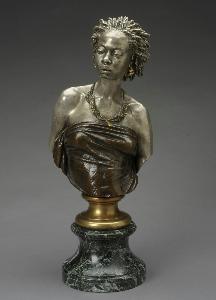Charles Henri Joseph Cordier
Charles Henri Joseph Cordier
Place: Cambrai
Born: 1827
Death: 1905
Biography:
, a French sculptor of ethnographic subjects, left an indelible mark on the world of art with his captivating works. Born in Cambrai in 1827, Cordier's artistic journey was significantly influenced by his meeting with Seïd Enkess, a former black slave turned model, in 1847.
Early Success and Notable Works
Cordier's first major success came with his plaster bust of Saïd Abdullah of the Mayac, Kingdom of the Darfur, a Sudanese man. Exhibited at the Paris Salon in 1848, this piece is now housed at The Walters Art Museum. In 1851, Queen Victoria purchased a bronze version of this work at the Great Exhibition of London.
Official Sculptor and Ethnographic Contributions
From 1851 to 1866, Cordier served as the official sculptor for Paris's National History Museum, creating an array of remarkably lifelike busts for their ethnographic gallery, now part of Musée de l'Homme, Paris. His work did not solely focus on 'exotic' models; he also depicted European types from various parts of France and beyond.
Artistic Credo and Legacy
In 1862, addressing the French Society of Anthropology, Cordier stated, Beauty does not belong to a single, privileged race, I have promoted throughout the world of art the idea that beauty is everywhere. Every race has its own beauty, which differs from that of others. This philosophy underpinned his artistic approach.
- View Cordier's works on Wikioo.org: Charles Henri Joseph Cordier | Wikioo.org
- Explore more about Musée de l'Homme, Paris on Wikioo.org: Musée de l'Homme, Paris | Wikioo.org
- Discover the world of ethnographic art with Wikioo.org: Discovering the Musée des Beaux-Arts de Carcassonne (France)
Conclusion
Charles Henri Joseph Cordier's legacy is a testament to his unwavering dedication to representing human diversity through art. His sculptures continue to inspire and educate, offering a unique window into the world's diverse beauty. Through Wikioo.org, you can explore more of Cordier's works and other masterpieces from around the globe. View Charles Henri Joseph Cordier's Artworks on Wikioo.org
Wikipedia link: Click Here







